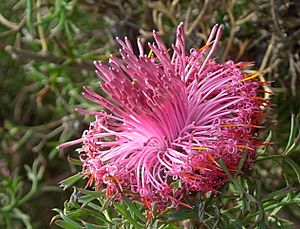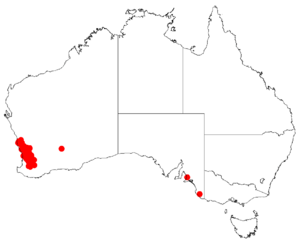Pincushion coneflower facts for kids
Quick facts for kids Pincushion coneflower |
|
|---|---|
 |
|
| Isopogon dubius in the Dryandra Woodland | |
| Scientific classification | |
| Genus: |
Isopogon
|
| Species: |
dubius
|
 |
|
| Occurrence data from Australasian Virtual Herbarium | |
| Synonyms | |
|
|
The Isopogon dubius, also known as the pincushion coneflower, is a type of plant in the Proteaceae family. It grows only in the south-west part of Western Australia. This plant is a shrub with special leaves and pretty pink flowers.
Contents
What it Looks Like
The pincushion coneflower is a shrub that usually grows to be about 0.5 to 1.5 meters (about 1.5 to 5 feet) tall. Its young branches and leaves are reddish-brown and covered in tiny hairs.
The leaves are quite unique. They are deeply cut into three parts or look like a feather, with sharp tips. Each leaf is about 25 to 55 millimeters (about 1 to 2 inches) long, and it sits on a stem-like part called a petiole that is about 20 millimeters (less than an inch) long.
The flowers grow in round heads, about 40 to 50 millimeters (about 1.5 to 2 inches) wide. These flower heads sit directly on the stem. At the bottom of each flower head are many hairy, egg-shaped leaves called bracts. The flowers themselves are pink to reddish-pink, about 25 to 30 millimeters (about 1 inch) long, and are smooth and hairless.
You can see these flowers blooming from July to September. After flowering, the plant produces hairy nuts that are joined together in a roundish head, up to 30 millimeters (about 1 inch) wide.
How it Was Named
The pincushion coneflower was first officially described in 1830 by a botanist named Robert Brown. He first called it Petrophile dubia. He found specimens of this plant near the Swan River in 1827.
Later, in 1917, another botanist named George Claridge Druce changed its name to Isopogon dubius. This is the name it still has today.
Where it Grows
The pincushion coneflower grows in woodlands and open areas with low shrubs, called heathlands. It is mostly found on the Darling Scarp in the south-west of Western Australia. You can find it in areas like Wongan Hills and Narrogin. It grows in specific regions such as the Avon Wheatbelt, Geraldton Sandplains, Jarrah Forest, and Swan Coastal Plain.
Conservation Status
The Government of Western Australia's Department of Parks and Wildlife says that this plant is "not threatened." This means it is not currently in danger of disappearing.
Growing Pincushion Coneflower
People started growing the pincushion coneflower in Europe in the 1800s. It's a plant that likes dry summers and soil that drains water very well. It can also handle some cold weather and light frosts.
For the best display of its beautiful flowers, it needs lots of sunshine. However, it can also grow in places with some shade.
Images for kids
-
Isopogon dubius in the Dryandra Woodland



